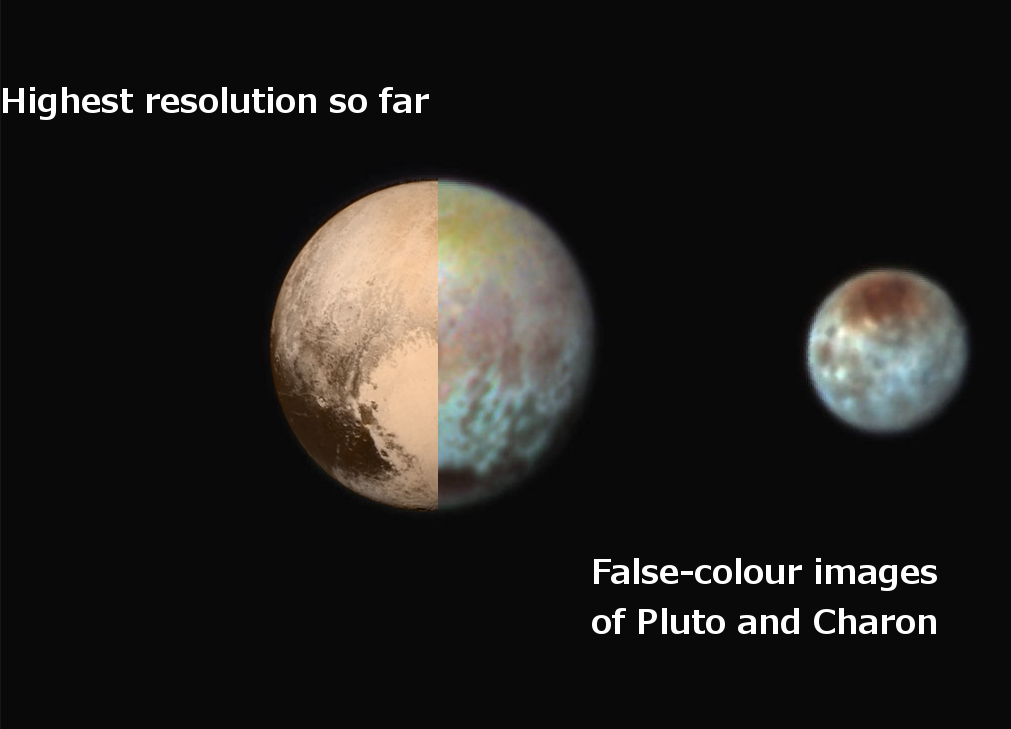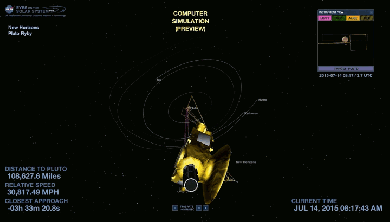Pluto pass makes space history
 UPDATE: New Horizons has made contact again - stay up to date on NASA's dedicated Twitter feed, accessible here.
UPDATE: New Horizons has made contact again - stay up to date on NASA's dedicated Twitter feed, accessible here.
After ten years and nearly 5 billion kilometres, NASA’s New Horizons mission has got the best glimpse of Pluto in human history.
There was cheering and jubilation at mission control in Arizona when the probe sent back the first new data, by way of the Canberra Deep Space Communication Complex.
In fact, Australian scientists are playing a crucial role in making the mission possible.
The probe shot past Pluto at over 45,000 km/h on a trajectory that brought it within 12,000 km of Pluto’s surface.
The moment the images came through was fittingly soundtracked by 'The Final Countdown' from the 1980s glam metal band Europe playing through speakers at mission control.
The mission has gone almost exactly to plan, with New Horizons’ taking just one minute less than predicted when the craft was launched in January 2006.
The spacecraft threaded the needle through a 60-by-90 kilometre window in space — the equivalent of a commercial airliner arriving no more off target than the width of a tennis ball.
New Horizons has now sent back impressive images of Pluto and its large moon Charon, which are coloured to highlight their compositional diversity. The exaggerated colours make it easy to note the differences in surface material and features on each planetary body.
The images were obtained using three of the color filters of the “Ralph” instrument on July 13 at 5:38 pm AEST. New Horizons has seven scientific instruments onboard, including “Ralph” and “Alice”, whose names are a throwback to the ’Honeymooners’, a popular 1950s sitcom.
“These images show that Pluto and Charon are truly complex worlds. There's a whole lot going on here,” said New Horizons co-investigator Will Grundy.
“Our surface composition team is working as fast as we can to identify the substances in different regions on Pluto and unravel the processes that put them where they are.”
The colour data helps scientists understand the molecular make-up of ices on the surfaces of Pluto and Charon, as well as the age of geologic features such as craters. They can also tell them about surface changes caused by space “weather,” such as radiation.
When earlier images arrived back to Earth, the team spotted a heart-shaped section on the surface of Pluto they dubbed a “love note” to the mission.
The new colour images reveal that the ’heart’ of Pluto actually consists of two remarkably different-colored regions. In the false-color image, the heart consists of a western lobe shaped like an ice cream cone that appears peach colour in this image. A mottled area on the right (east) side looks more bluish. A mid-latitude band appears in shades ranging from pale blue through red. Even within the northern polar cap, in the upper part of the image, various shades of yellow-orange indicate subtle compositional differences.
 The surface of Charon is just as colourful, and therefore chemically diverse. The red on the dark northern polar cap of Charon is attributed to hydrocarbon and other molecules, a class of chemical compounds called tholins. The mottled colors at lower latitudes point to the diversity of terrains on Charon.
The surface of Charon is just as colourful, and therefore chemically diverse. The red on the dark northern polar cap of Charon is attributed to hydrocarbon and other molecules, a class of chemical compounds called tholins. The mottled colors at lower latitudes point to the diversity of terrains on Charon.
“We make these colour images to highlight the variety of surface environments present in the Pluto system,” said Dennis Reuter, co-investigator with the New Horizons Composition Team.
“They show us in an intuitive way that there is much still to learn from the data coming down.”
Due to the five-billion-kilometre distance to Pluto, data takes 4 ½ hours to come to Earth, even at the speed of light.
It will take 16 months for all of New Horizons’ science data to be received, and the treasure trove from this mission will be studied for decades to come.
The team says it will soon be able to release images that are more than 10 times the resolution of those already published.
New Horizons' flyby of 2,370km-wide Pluto is a key moment in the history of space exploration; marking the investigation of all nine objects considered by many to be the Solar System's planets - from Mercury through to Pluto.
New Horizons has caught glimpses of not only Pluto and Charon, but also the four smaller moons in the system: Styx, Nix, Kerberos and Hydra.
To achieve that, it performed a furious set of manoeuvres during the flyby, pointing in dozens of directions to lock on to the different targets.
The scientists that have been working with New Horizons for over a decade now face an agonising wait for news from the spacecraft, which is due to call home again later today. It will be only after a 15 minute-long signal is received that NASAofficials will know whether New Horizons actually survived the flyby.
After taking a few more shots on its way past, the probe will continue into an even more mysterious part of space - a region at the edge of the solar system called the Kuiper belt. Astronomers call it the ’third zone of space’.
The first zone includes the rocky, terrestrial planets of Mercury, Venus, Earth and Mars, The second zone houses the gas giants, Jupiter, Saturn, Uranus and Neptune. The third contains the Pluto system and the Kuiper belt of comets and more than 100,000 miniature worlds.
New Horizons will be able to continue its long journey powered by a nuclear generator that runs on plutonium, a substance named after the dwarf planet. The generator should let it run until the 2030s, by which time it will be 100 times further away than Earth is from the Sun, drifting into some truly unknown regions on the way.







 Print
Print